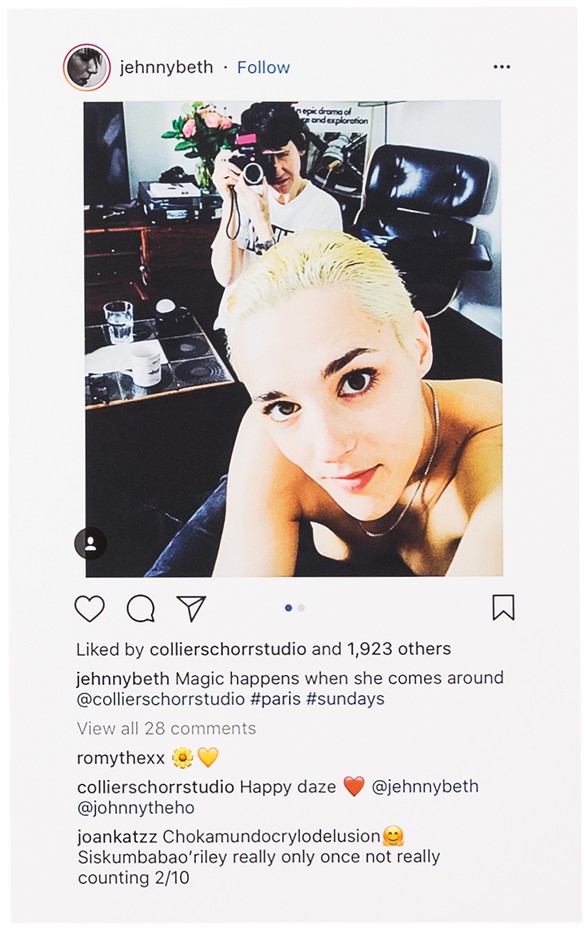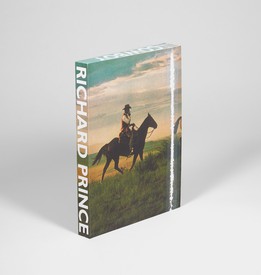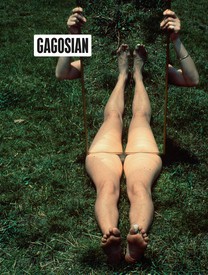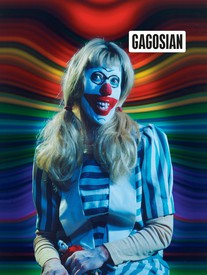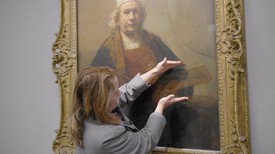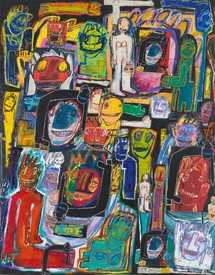
Natasha Stagg’s books Surveys and Sleeveless: Fashion, Media, Image, New York 2011–2019 were published by Semiotext(e). Her writing also appears in the books You Had to Be There: Rape Jokes, by Vanessa Place, Intersubjectivity, Volume 2, edited by Lou Cantor and Katherine Rochester, Excellences & Perfections, by Amalia Ulman, and The Present in Drag, edited by DIS, among others. Photo: Roeg Cohen
About a year ago, I was working at a branding consultancy with fashion clients interested in YouTube stars while promoting the German translation of a novel I wrote that had made predictions about new methods of fame and cultural leveraging, and so was inundated with takes on “influencer culture.” I watched the first episode of a new Vice show, hosted by obsolete prototype Paris Hilton, that tracked a social media star’s path of fakery in search of making it and likened becoming a top-tier personal brand to getting a dream role in Hollywood. I saw mass-market celebrities trail niche personalities when starting beauty lines. I read about the proliferation of branded selfie ops, “relative diminishing marginal aesthetic value,” the first animated-bot news anchor, and the limitlessness of media manipulation through digital developments in the near future. All this while participating in and performing for multiple media formats myself, often with the goal of self-promotion.
I’d noticed that a lot of people are somehow still under the impression that the influencer strategy of advertising doesn’t affect them—or they were under that impression until their daughter or friend or mother started the process of social media monetization. I imagine that realization like finding out that someone you know is selling products as part of a pyramid scheme, but a scheme as all-encompassing as television and radio and print advertising combined. It’s debatable whether influencer marketing is sustainable as a model, but for now, agencies will attach value to any level of influence and will attempt to make gains from any or all of it.
Influencer marketing was already old hat, a strategy that should have given way to something new. Like cringey hashtag campaigns, though, it became ever more integrated into the advertising infrastructure it was supposed to subvert or at least circumvent. Perhaps this boom, due to ad executives hoping to attract postmillennials, was driven by the teenagers they polled. For many, it was influence or die. The feeling was tangible.
In the early summer of 2018, I received an email from a publicist about Vancouver’s “influencer marketing and content platform” #paid (hashtagpaid.com), and although I hardly ever get baited by press releases, something compelled me to respond to this one. I was curious about the agency’s processes, I said. The publicist suggested a phone interview with Adam, the twenty-five-year-old cofounder and CSO. Like any amateur journalist, I made my first question about how the startup started.
The old advertising questions about efficacy and tactics remain, but when they’re applied to the influencers, it’s in everyone’s interests to be portrayed as extremely normal.
“A friend of ours, Ronnie, from Toronto, amassed over 100,000 followers in a year,” began Adam. The year and platform in question are 2012 and lnstagram. Adam drew out certain words in a distinctive style I think of as pitchspeak, which makes the impossible promise of relevancy. In a clever tactic meant to simplify complicated explanations, each phrase is reduced to an emphasis: “We started analyzing what she was posting, how her followers were reacting. Commenters were asking her what gym she goes too, what sports bra she wears, what protein she puts in her shakes. She’d give them honest answers. That’s when we stepped in and said, Hey, she’s endorsing brands without getting paid.”
Influencer marketing is a multipronged term including mega-, macro-, and micro-, and each level comes with its own package of associative benefits. Influence is applied to everyone who has any type of following, from an average social media user to the most-followed person on a given platform. Everyone is susceptible to advertising, but if we all exhibit differing levels of influence, we also all exhibit differing levels of influence immunity. Relative “authenticity” is a measurable factor here as well, the definition morphing into something like “engagement potential.” The old advertising questions about efficacy and tactics remain, but when they’re applied to the influencers, it’s in everyone’s interest to be portrayed as extremely normal.
Which is most effective: an influencer whose stock is high but whose motives are completely transparent, or someone subtler, whose earnest personal branding isn’t easily distinguishable from sponsored content? Every social media user falls somewhere between the two poles. If anyone can be a potential source of “authentic” advertising, is anyone truly authentic online? These are not the kinds of questions that bothered Adam, who became Ronnie’s manager when they were both nineteen. When I looked at her Instagram account, it was a trove of before-and-after pictures that utilized all the old selfie tricks like better lighting, flattering bikinis, and self-aware posture. The food photos she posted were a mix of calorific desserts and colorful fruit salads. She often updated her followers on the health of her long-term relationship (now engagement!). In these photos, two grinning, blonde, blue-eyed high school sweethearts were always careful to make eye contact with the camera. To promote her e-commerce shop, shots of the merch: pillows, mugs, totes, and framed posters with inspirational messages like “Less greed more giving.”
Not that I’m judging. We are all of us necessarily familiar with and somewhat accepting of a double self-image: the contrast between a life and the image of that life as projected online. We each create a personal brand. We each author a narrative of depicted moments. We sometimes wonder about the dichotomy between the moments we share and those we don’t, about how it relates to a truth, or a core, if those exist. What was authenticity in another era? And what amount of authenticity is lost when we’re promoting a cause, associating with a brand, selling a product—or selling ourselves?
When Adam and Ronnie first started working together, they compiled a list of ten brands she either already used or wanted to work with. Adam reached out and brokered deals on his new client’s behalf, at which point she was legally obligated to add the word “Ad” or “Sponsored” to posts she was paid to make. But, says Adam, “it wasn’t a stretch because we weren’t forcing the brands at her. Her followers weren’t surprised because she was already giving them product recommendations, since they were asking for it. Now, she’s just earning revenue from these recommendations, versus the free replies she would write in her comments section.”
Influence should be easy to determine: follower counts tell the story and analytics do the rest. But every good marketer knows that’s not enough. If you’re scrolling past an ad and land on a meme making fun of the flaws in the very same ad, your like might not be worth that much. In a vicious cycle, ads incorporate sarcasm and meme mimicry. This is how you get fast-food Twitter accounts anonymously authored by comedians. Corporations, as they say, are people. And people, it seems, are corporations.
The dream of influencer marketing is to make ads from potential posts created by the kind of people who know how to make their friends and family jealous. The goal is to blend in completely, to deploy a truly personal aesthetic, created by users themselves. The ideal user exudes an air that’s aspirational but attainable. Her life is smoothed out and sunny, not overcomplicated with too many messages. She and her friends are just normal people having fun because of the products they’ve purchased.
If we all exhibit differing levels of influence, we also all exhibit differing levels of influence immunity.
I had heard the term “micro-influencing” before speaking with Adam, but probably didn’t investigate its meaning. A micro-influencer, it was explained to me, is a social media account that has a better impact on its followers because it has a smaller, more trusting following than the typical movie star or name-brand account does. Companies target smaller and smaller advertising platforms in order to set in motion word-of-mouth endorsements that people are more likely to believe. According to this logic, micro-influencers (or anyone with a following under 100,000) are normal people who happen to be passionate enough about shopping to want to advise others on the quality of the products for which they shop.
Companies, from what I understand, pay influencers to promote their products in a way that each entity has agreed feels natural to their own brands. Companies could also send gifts to influencers, expecting but not contractually obligating a promotion, whether it be a YouTube review or a tabloid photo. Since the recipients of these gifts are not legally beholden to alert their fans of a paid promotion, the gift tactic serves as a loophole in two directions. To the company, unpaid and therefore unannounced advertisements appear more authentic. To the influencer, meanwhile, a gift can add value to a personal brand: posting a thank-you note to a brand promotes the brand, but also one’s self, suggesting one is important enough to receive free products.
To hear it from the guys at #paid, brands are doubly served by micro-influencer partnerships: followers are more likely to look kindly on a brand that contributes to the livelihood of a beloved noncelebrity, and a brand that invests in a personality comes to reflect that personality, a real, authentic person. The authenticity, whatever that means, bubbles upward.
Micro-influencers don’t look like Hollywood superstars or fashion models. While elite celebrities are mostly superthin, influencers are athletic and rounded. They flaunt their extravagant vacations, loving relationships, and stable home lives, even as they remain grounded enough to foster a large group of adoring friends. This is the lifestyle, it seems obvious now, that America has always truly wanted.
Before influence was a traceable statistic, “influential” used to mean “cutting edge.” But an influencer isn’t influential in that way anymore. A typical influencer today is basic—the opposite of avant-garde. She’s the affluent, pretty person you’d rather not admit you pay attention to because she is, by default, a sellout. Still, although you may not even know her name, there’s something about her skin that makes you sick with envy. She’s not plagued by celebrity scandal or even a career, and yet she’s incredibly, impossibly popular. In the daydreams of her followers, she wakes up every morning to an excess of opportunities, each more fun than the previous one.
“influential” used to mean “cutting edge.” But an influencer isn’t influential in that way anymore. A typical influencer today is basic—the opposite of avant-garde.
Does the micro- or macro-influencer sell happiness? She’s not famous for her talents—at least not yet—but she’s still being paid to document her lifestyle. Her influence is acute; it’s measurably more powerful than the effect a big celebrity might have on her millions of fans. Because she is a no one, she’s someone. It’s this type of person—not her much wealthier or more famous colleagues—that is our era’s real trendsetter.
“Influencer” is what we’re calling them now, but that’s just one in a timeline of those words invented to describe celebrities who are first and foremost talented at utilizing new media. The linguistic evolution has taken zeitgeisty terminology from alluding to the dramatic to pinpointing the vanilla. In other words, we’ve gone from coveting the few to the many, the iconic to the algorithmically induced.
“Influencers” were once called “it girls,” a term I never thought I’d miss. After speaking with #paid, though, I reread Jay Mclnerney’s 1994 New Yorker profile “Chloe’s Scene” to try and remember what it used to mean to be influential and young. Mclnerney famously names Chloë Sevigny “the coolest girl in the world,” based on her ability to spot and insert herself into trends. In the 1990s, she was in an early Sonic Youth music video, Larry Clark’s first movie, a Maison Martin Margiela fashion show, and a Bernadette Corporation short film, for example. In the profile, the high schooler is effortless, unreachable (she clearly doesn’t have a pager and is hardly ever at home), and in demand. She chooses modeling for indie magazines over Vogue Italia, since, as Mclnerney describes it, “‘Down low’ is a cherished concept: secret, alternative, not commercial—everything one wants to be. Except one also sort of wants to be famous, and here is the contradiction at the heart of Chloe’s world, the dilemma of subcultures that ostensibly define themselves in opposition to the prevailing commercial order, the dilemma of all the boys and girls who want to be in Paper and Details: What do you do if Harper’s Bazaar, or Calvin Klein, comes calling? In Chloe’s case, so far, you sort of blow them off.” Twenty-four years later, though, she surely wouldn’t. Who would?
In his pitch, Adam had spun the refusal to sell out as irrational and maybe inauthentic. “Another way to view this is,” he continued, “[marketers] are giving money to help support that creator to create even more amazing content that their audience loves. So from the audience’s standpoint, it’s not like [creators] are paid for a product placement, it’s more like a validation. It’s that this amazing brand believes in the creator—person—that I follow, and now they’re helping that creator make a living. It’s about the creator continuing to make content. That’s the change, in terms of the mindset.” As if in conclusion, he added, “I don’t really think it’s about selling out anymore.” The rationale was cyclical: entertainers must earn money and the entertained must pay up in some way. “Even if you don’t have a significant following, you understand that if you expect someone to create a weekly YouTube video or post on lnstagram every day and commit their lives to creating content for you, then they need to make money somehow.”
As he compared paid posts to charitable acts, I could hear Adam almost start to believe himself. Many agencies, including #paid, promise a seamless monetization of social media posting: get paid to do the hard work you’re already doing by providing the world with engaging content, their mission statements all say, in so many words. Your brand is already established, they coax. If you’re not making money from it, you’re working for free.
This fair-is-fair explanation is not really how economies work, including the attention economy. Still, countless startups will hinge their success on managing these projections. Meanwhile, talent and creative agencies have scrambled to rebrand themselves as specializing in influencer marketing. On hashtagpaid.com, an interactive slider calculates how much you can make per post based on average engagements. A button below it encourages visitors to “start getting paid” by joining the 15,000-strong “creator marketplace” established across over one hundred countries.
For one of the agency’s macro-influencers, who describes herself as a “content creator,” the promotional life is a form of preparation for whatever comes next. She doesn’t see herself doing paid posts forever: “I am already seeing a shift in the social media world, and these platforms will surely give out on all of us eventually.”
Excerpted from “Right Time,” originally published in Sleeveless: Fashion, Image, Media, New York 2011–2019 (Semiotext(e), 2019)
